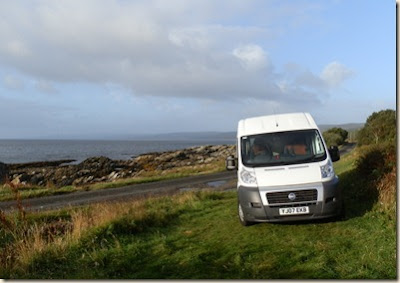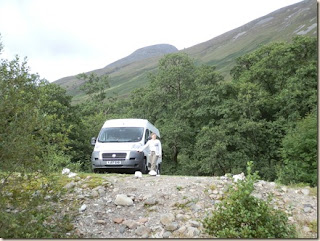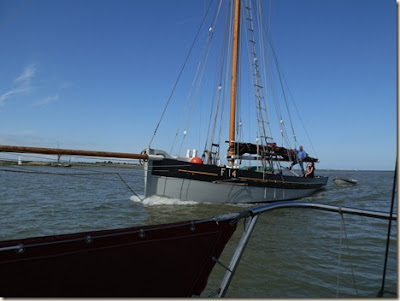We start our wee break on
Cirrus (not a holiday, of course, as retired people don’t get these) by having a close encounter with a paddle steamer, none other than the newly restored steamship,
Waverley.
She was making a brief stop in Campbeltown, just as the steamers would have done a hundred years ago, and her departure, reversing away from the quay at speed, her decks lined with waving passengers, was exactly how it would have been on any of the Clyde steamers. Out in the centre of the loch she performs the nautical equivalent of a handbrake turn before steaming off south (forwards) around the Mull and heading off north to Oban. As it happens we time our own departure just before she got underway and thus we have the best view possible of this little slice of living history.
The rest of the day passes more gently as we drift north trying to persuade
Cirrus’ sails that there is enough of a breeze to fill them. Unlike on our two previous encounters with Kilbrannan Sound, both in strong winds, we now have a chance to sail and then motor close by the shore, dipping our twin bows into each bay in turn. First we pass the ruins of Kildonan Dun, where we are surprised to note how the tiny Ross Island creates a good sheltered bay, an attractive place for the ancient people who settled here to build and set up their home. The relationship between land and sea is not evident from on shore – only from a boat does this place become a logical stopping point.

At Saddell Bay the castle peeps out from the corner in fine style as we creep in, as close as our echo sounder tells us is safe. The sun beats down on us as we cross Torrisdale Bay then finally we slip slowly to anchor in Carradale Bay, just a short distance from our home. Three and a half metres of water is all that separates us from the bottom but it feels like we are in a world of our own here, bobbling gently up and down on the slight swell. Those on land are no doubt suffering the midges, which are particularly troublesome just now whenever the wind falls light, but these little insects are poor flyers so we have every hope that they find it difficult to cross the short stretch of water that separates us from land; and so it proves.
After a peaceful night we wake early to find the motion of the boat has changed. Now
Cirrus is wobbling from side to side as waves pass beneath her although the wind is still very light. Whatever is happening it is getting uncomfortable so we decide to leave, early though it is, but as soon as we leave the shelter of the bay the true wind hits us, a north-easterly blast at 15 to 20 knots, and the waves driven by this are rolling down Kilbrannan Sound. The nearest shelter from this wind is Lochranza on Arran, some 10 miles away, so we motor upwind as best we can and attach ourselves to a blue visitor buoy there. This place, which lies west of the most mountainous part of the Isle of Arran, has a reputation for ‘williwaws’, strong wind gusts which can occur to the lee of high ground, and these now sweep down on us throughout the rest of the day and through the night, creating much noise and fuss.
Cirrus takes all this in her stride, however, so we feel safe and secure.
The following day is a Sunday, and to our surprise we notice buses running on their usual routes around the island. So after pumping up the dinghy we scuttle ashore and soon find ourselves on our way south to the settlement of Blackwaterfoot which lies in the Lowland part of the island. Like Bute, Arran is also bisected by the Highland/Lowland divide and the character of the south of each island is typical of the Lowlands in both places. There are steep cliffs of red sandstone here, identical in every way to the rocks we noticed just south of Rothesay on Bute only a few weeks ago yet the two islands are separated by the waters of the Clyde.

In both cases these are all old sea cliffs, formed before the land rose up above its present level and on Arran around 6,000 years ago the ancient sea cut massive caves, one of which was reputed to have been once used as a hiding place by Robert the Bruce. This would have been around the same time as he visited Port Righ (royal port) just across the Sound in Carradale. Of course Uamh an Righ, or King’s cave as it is locally known, is bound to have seen human habitation prior to King Robert’s time, it being such an obvious choice for someone needing shelter from the elements but lacking the time or the skills to build. This imbues the place with almost mystical significance, in my view. Of what other places of human habitation can it be said that so little has changed. The walls, the floor, the smoke-stained ceiling, are all exactly as our ancestors left them.

And as if to emphasise this quality just along the shore only a short distance from the cave there is a ‘grove’ of stone cairns, each stone magically balanced on the one beneath and somehow surviving despite the ravages of wind and rain. Created by some unknown artist, perhaps, or else by ancient man and lying undisturbed ever since. And maybe there is some critical alignment of the stones that I missed for out across the sea to the south lies Sanda Island off the tip of Kintyre and beyond this, Ireland, another country. Arran is full of mystery, it seems.
When the morning brings us lighter winds we motor off across Inchmarnock Water to the island of the same name. Uninhabited, unless you count the cattle, there is a small cove on the eastern shore in which a boat like ours can drop an anchor so the crew can eat their lunch. We take shelter from the powerful sun for a time then raise sail to float away northwards again up the West Kyle. White sails are now to be seen in most directions, although this place can never be called crowded, but as the Kyle narrows we begin to wonder whether our chosen anchorage at An Caladh will be full. Not to worry, of course, for there is always Wreck Bay on the ‘Buttock’ of Bute with space for us to drop the anchor, pause to ensure it is well dug in, then settle down for the night.
Come the morning,
Cirrus is still in exactly the same place, which is always a comfort when you are attached to the land only by a slim length of chain. The day started cool so we light our diesel heater (the same troublesome stove we were swearing at only a few weeks ago but which now has a ‘New, Improved’ chimney attachment to carry the waste gases higher than ever before into less turbulent air) and just as it was supposed to, the temperature inside our boat begins to rise. A heron lands with perfect grace on the edge of the shore beside us then stands motionless waiting for fish to come its way. This is the most patient of birds and lives by proving the adage, ‘Dinner always comes to those who wait’ and is a treat to see at close quarters.
Our local weather forecast promises some south-easterlies so a plan is hatched that might give us some decent sailing a little later and we motor off down the East Kyle towards Rothesay.
Imagine our surprise on arrival, however, to find the substantial Victorian houses here dwarfed by a mighty cruise ship, the Ocean Countess, which has dropped its own anchor in the bay. I wonder whether the captain goes through the same procedure as us when anchoring – let the boat run back until jerked to a halt by the anchor biting into the sea bed, let out some more chain, check the boat has enough room to swing, set a depth alarm, light the anchor light – or does he just give orders and let someone else worry about these things. I rather fancy things might be dealt with rather differently on a ship of this scale.
After passing Rothesay, Bute’s principal harbour, there are two more islands, Great and Little Cumbrae which we motor past because the wind has not as yet performed as the forecaster promised. Indeed we soon begin to feel he was having a little joke with us for instead of a ‘south-easterly backing easterly’ the wind is set firmly in the south, exactly the direction we had decided we might like to head. Since beating upwind is not something we choose to do with any relish, and having the whole of the Clyde at our disposal from which to pick an alternative destination, we bear away (a nautical term for steering away from the direction from which the wind is coming) for Lochranza and soon find ourselves charging along at 7.5 knots with all our sails straining hard. Massive dark clouds blot out the horizon and are creeping ever closer so that by the time we pick up a mooring in Lochranza the rain has overtaken us.

Thus it continues throughout the night and early morning, to the disappointment of many, no doubt, who would have arisen early to try to catch sight of the transit of Venus across the face of sun. Our own position, with Arran’s biggest hills to the east of us, gives us no chance at all of seeing anything close to the horizon no matter how clear the sky.
So instead of Venus, here is a nice picture of a swan.














































